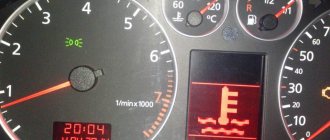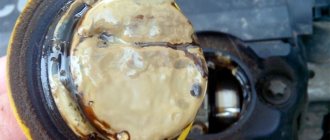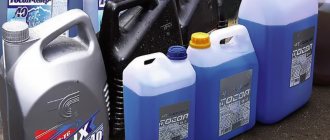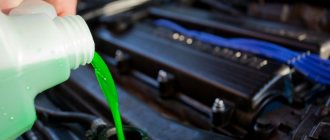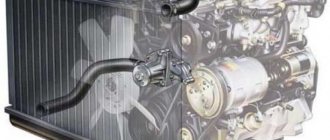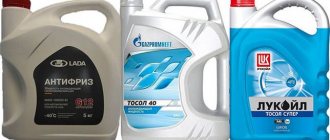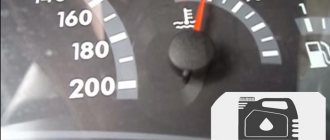The coolant consists of antifreeze, water, special additives, such as corrosion inhibitors, which protect the cooling system of an internal combustion engine from processes that are directly related to corrosion, and also protect the liquid itself from various kinds of negative influences and from thermochemical destruction. In addition, this substance protects all lubricants for the vehicle cooling system pump (pump).
Antifreeze is a specific compound. When this compound is mixed directly with water, the freezing point of the mixture drops significantly. Thus, antifreeze can be called almost any aqueous solution of inorganic salt (calcium chloride, potassium, sodium), alcohol, aniline, glycols, glycerin, carbinol and similar chemical elements.
In the modern world, the main coolants used in the automotive industry are liquids whose main component is ethylene glycol. This element must be diluted with water in the following proportions: ethylene glycol-water ratio – 1:1; 2:3 and also 1:2.
Propylene glycol antifreezes are less toxic substances and also have a significantly lower boiling point. This explains the high cost of this kind of substance.
All ethylene glycol coolants have certain quality specifications. This, in fact, is where the differences from each other lie: the set of necessary additives, the degree of dilution with water. All coolants based on glycol are highly toxic if ingested. Due to the fact that they taste quite sweet, pets and children are often poisoned by such chemicals. In some specific regions around the world, legislation has been passed to make it mandatory for manufacturers to add bitter flavoring additives directly to antifreeze. A person’s sensations when poisoned by this kind of substance have a direct effect on the central nervous system. This results in loss of coordination, vomiting and severe weakness. The best antifreeze is ethyl alcohol, which has a temperature of 40 degrees. In modern times, this antifreeze is not widely used, as it has a very high cost, volatility and flammability.
“Antifreeze” is a trade designation for coolant, the main difference of which from others is the quality of non-freezing.
This model was developed back in the USSR, however, at present, this word has already become a common noun. It is important to know that the basis of Antifreeze is ethylene glycol. Antifreeze is intended to cool the internal combustion engines of cars at any time of the year within certain temperatures that are specified in the brands and models of vehicles. The numbers 65 and 40, which appear in the brands of Tosol liquid, indicate the beginning of the freezing temperature of the model and make of the car. The lowest temperature needed to freeze an ethylene glycol-water system is about -70 degrees.
Boiling point of antifreeze and its other features
To move on to the features of this liquid, it is necessary to understand what coolant is, and also why such liquid is needed in the vehicle system. It is important to know that during the moments of direct operation and operation of the vehicle by the motorist, some special individual elements have the quality of strong heating. To avoid the failure of such devices, in fact, a special cooling system of the car is necessary. It is into this system that the coolant is poured, or, as it is commonly called in automotive slang, anti-freeze.
In general, if you look at it, antifreeze can easily be classified as one of the types of antifreeze. However, the whole point is that this kind of liquid appeared only a few decades ago, when the VAZ car appeared, and at that time it was of excellent high quality. If we talk about the current situation of all things, the situation has changed completely. This is due to the fact that a new “creation” has appeared on the automotive market - antifreeze, the quality of which is several times higher than the quality of domestic antifreeze. The whole secret of this difference lies in the fact that both one and the other type of coolant contain a complex of certain special additives. In antifreeze, these additives are selected in a functional manner to protect all metals (cast iron, aluminum alloys, copper, brass) from which VAZ cars and engines are made from oxidation.
That is why all owners of domestic vehicles should give preference to the domestic manufacturer of antifreeze antifreeze. Antifreeze is essentially an imported coolant. Based on this, it would be more advisable to use this liquid for those whose car is a foreign car. As for the freezing temperature itself, it is quite similar in both cases, only the boiling point of antifreeze is 120 degrees, and antifreeze is 110 degrees. The difference, it would seem, is not big, but during the periods of solstice and summer heat it plays its assigned role.
Why does antifreeze boil and how to notice it?
If antifreeze liquid begins to boil, the most dire consequences can occur. It is because of them that a huge amount of capital investment may be required for partial repairs or a complete replacement of the cooling system, or even worse, the car engine. It will not be difficult to understand that this problem has arisen in your own vehicle: steam will “fly out” from under the hood of the car in all respects; in addition, the engine power will decrease significantly, while fuel consumption will increase significantly. In addition, it is important to know that if the engine boils frequently, its service life is significantly reduced. Sometimes, such an indicator can reduce the period by two or three times.
This problem occurs for a number of specific reasons. Often, this malfunction occurs due to low-quality coolant. That is why you should select the coolant very carefully; you should not chase the price, but you should purchase it only from reliable points and car services. In addition, the reasons for this phenomenon are clogged radiator, poor sealing of the cooling system and insufficient fluid level. In addition, if a radiator fan, thermostat or pump fails, similar problems may arise, as a result of which you can pay very dearly for your own negligence and absent-mindedness.
We recommend: Crankshaft - what is it and how does it work?
How to prevent antifreeze from boiling?
In addition to the fact that it was important to learn about the reason for the boiling of antifreeze in the expansion tank, there is no less important knowledge. This information is to protect the device from boiling, to prevent this process, and how not to make a mess if such a situation arises for a car enthusiast. It is important to know: if, unexpectedly for the car owner, the coolant boils while the vehicle is moving, and characteristic white steam begins to appear from under the hood, then urgent measures must be taken.
The first aid in this situation will be to immediately stop and further cool the system. After this, you need to immediately identify the cause, and then eliminate it as quickly as possible.
There is an elementary method that helps prevent this type of situation from occurring. The easiest way is to constantly take care of the car, timely maintenance of the vehicle, as well as a daily procedure for checking the condition of the car. In cases where even the slightest hint or prerequisite for the occurrence of a “disease” arises, everything must be stopped and treated immediately. In addition, an important element is the use of high-quality liquid. It is high-quality substances that can be universal and suitable for all types of cars. It is important that during the moments of its movement, the internal combustion engine heats up to a temperature of 90 degrees, while antifreeze is capable of taking about a third of this heat. That is why the importance of this kind of fluid for the successful functioning of a vehicle is very difficult to overestimate. In terms of importance, it can be compared to motor oil or brake fluid. Consequently, the entire cooling system in a vehicle plays one of the most important roles.
A little physics
It is incorrect to talk about the boiling point of antifreeze in the specifics of antifreeze, since, firstly, antifreeze has a certain chemical composition, and its thermophysical characteristics are determined not only by temperature, but also by pressure. Secondly, antifreeze, which at one time was created exclusively for domestically produced engines, contains additives that ensure not only the operation of the car at low temperatures, but also its protection from a number of unfavorable factors:
- corrosion;
- wear;
- cavitation.
Antifreeze, unlike antifreeze, does not have a lubricating effect, and wear reduction is achieved due to a decrease in the temperature of the moving elements of the drive, with an increase in which the gaps are selected and the friction coefficient naturally increases.
If everything is more or less clear with the permissible temperature (no more than 90ºС), then with the pressure in the engine the situation is more complicated. To protect the engine from overheating, antifreeze is pumped at elevated pressures, which also affects the temperature of the liquid. For most brands, the actual pressure in the cylinder block is at least 1.2...1.3 at: it is then, according to the Clausius law, that the maximum temperature required for boiling liquids increases. Thus, the theoretically permissible boiling point of coolants can be 110...112ºС.
What to do when antifreeze boils
If the antifreeze begins to boil, thick smoke comes out from under the hood, and the engine temperature gauge shows more than 100 °C, then you need to act immediately. First, you must immediately remove the load from the engine. To do this, turn on neutral gear and stop smoothly without turning off the engine. At the same moment, you need to turn on the fan or heater so that the power unit of the car cools down faster. We turn off the engine only after the car has completely stopped, but leave the heater on.
Smoke from under the hood of a car
Next, open the hood of the car to ensure air flow to the engine, and wait about 20–30 minutes. Do not open the expansion tank under any circumstances, otherwise antifreeze may splash into your face in a powerful stream! After the engine has cooled down, you need to call a tow truck. If this is not possible, you need to perform the following steps.
First, open the expansion tank and add a small amount of antifreeze. Next, we start the car and slowly move towards the nearest workshop. While driving, you need to carefully monitor the engine temperature. If the sensor needle approaches the 100 °C mark, then the car needs to be stopped and only after a while continue moving.
Adding antifreeze to the expansion tank
If you already have experience repairing the cooling system, you can try to fix the problem yourself. To do this, you need to clean the cooling radiator, replace the pump and fan. After this, it is necessary to disconnect the pipes from the thermostat and eliminate the air lock. If necessary, you need to replace the coolant temperature sensor. However, it is best to entrust such work to specialists. You should constantly monitor the temperature of the power unit and be sure that the refrigerant will not boil or freeze in your car.
Basic functions of antifreeze
What is antifreeze? This is the liquid that circulates in the cooling and heating system of a car. It removes excess heat from the engine and, if necessary, heats the interior. Antifreeze (antifreeze) contains antifreeze and anticorrosion additives. Usually the number after the brand name indicates the freezing point of the antifreeze.
The boiling point of high-quality antifreeze is +108-125 °C. This temperature is maintained with a sealed and properly functioning system.
Over time, antifreeze loses its qualities and must be changed regularly (at least once every 3-5 years).
If signs of boiling appear, stop and cool the engine. If you know that the shelf life of the antifreeze in the system is fine, you need to look for why the antifreeze is boiling in the expansion tank of the VAZ 2114.
If antifreeze is boiling, it is better to get to the nearest car service center as quickly as possible. Otherwise, the cooling system and an overheated engine will require serious repairs and investment. With frequent boiling, the service life of the engine is reduced by 2-3 times.
What to do in case of boiling?
If Antifreeze is boiling, smoke is coming from under the hood, and the engine temperature gauge needle shows more than 100 degrees, then you need to do the following:
- First you need to immediately stop loading the motor. That is, you need to engage neutral gear and move until it comes to a complete stop, without turning off the engine. At the same time, turn on the heater or fan so that the engine cools down at least a little;
- After stopping the vehicle, the engine must be turned off, but the stove does not need to be turned off. A working heater will allow the engine to cool down a little;
- open the hood of the car to provide airflow to the engine;
- then you need to wait 20-30 minutes;
- It is strictly not recommended to open the expansion tank with coolant, otherwise hot antifreeze may simply spray out of it and burn the driver’s skin;
- when 30 minutes have passed, look for someone to take you to the service station. You can take the car towed or call a tow truck;
- if going to a service station is not an option, then open the expansion tank and add refrigerant, then close the hood and drive to the nearest service station with the heater on. Look how much fluid is in the expansion tank. If it is not there, then do not rush to fill in the refrigerant: sudden cooling is harmful to the system. In this case, it is necessary to control the engine temperature: if it exceeds 100 degrees, then stop the car and wait until the temperature drops. If the temperature goes beyond 100 degrees several times, then there is a possibility of motor failure. If the engine misfires, then it is necessary to change the gasket on the cylinder block;
Sediment in the pipe after using low-quality refrigerant
We recommend: Selecting semi-synthetic motor oil
If you have the necessary knowledge, you can try to fix the breakdown on the spot.
To do this, you need to diagnose the parts and, if necessary, replace:
- thermostat;
- clean the cooling radiator;
- replace the pump;
- change the fan;
- disconnect the pipes from the thermostat and get rid of the air lock;
- Replace the antifreeze temperature sensor.
It is better to entrust such work to a specialist if you are not confident in your abilities. The temperature of the engine must be constantly monitored to prevent such malfunctions from occurring, but if it boils, then follow the steps described above.
General diagnostics of the cooling system
If the car constantly overheats, pay attention to the serviceability of the cooling fan switch and the fan itself. If the switch or DTOZh malfunctions, remove the power connectors from them. This will put the system into emergency mode, in which the electric fans will constantly operate. If there is a problem with the control, you can bridge the power contacts of the fan relay, causing them to forcibly rotate when the ignition is on. This way you can quickly reduce the engine temperature and drive to the nearest service station.
If antifreeze boils frequently, it is also worth checking the serviceability of the viscous coupling and the degree of contamination of the radiators. Over time, the space between the air conditioner radiator, intercooler, automatic transmission radiator and main heat exchanger becomes covered with a dense “blanket” of dust, litter and fluff. Reducing the capacity of the cells leads to overheating and boiling of the antifreeze. The radiator can also become clogged inside, which can be seen from its uneven heating.
At what temperature do antifreeze and antifreeze boil?
Antifreeze is essentially a type of antifreeze and appeared on the market decades ago along with the appearance of the first VAZ cars. At that time he had excellent characteristics. Each coolant differs from other liquids in the presence of a certain type of additives designed to protect engine elements from corrosion and wear. The additives contained in antifreeze are best suited for VAZ engines. Antifreeze is of the best quality and is intended for engines of imported cars.
To distinguish between types of coolant, dyes are added to them. Usually the colors are red, blue or green. Thanks to this, and the fact that the expansion tanks are made of translucent plastic, the driver can quickly and accurately determine whether there is enough coolant in the system. When the coolant loses its original color, it indicates that it is time to replace it. Next, I will talk about in what situations antifreeze can boil.
The freezing point of antifreeze and antifreeze is the same (depending on the coolant concentration), and the boiling point of antifreeze is slightly different from the boiling point of antifreeze. For antifreeze the boiling point is 110 °C, and for antifreeze it is slightly higher - 120 °C. The temperature difference is small, but in the hot summer it can be significant.
The above values for the boiling point of antifreeze and antifreeze are correct for a fully functional engine cooling system. If there are foreign impurities in the antifreeze or antifreeze or the expansion tank cap has lost its tightness, the boiling point may be lower.
How to check the expansion tank cap?
If, when unscrewing the cap of the expansion tank on a warm engine, you do not hear the characteristic “puff” of gas escaping into the atmosphere under pressure, the pressure reducing valve is faulty.
Be extremely careful when unscrewing the expansion tank cap on a warm engine. Excessive pressure in the system causes some of the hot antifreeze to escape through the neck. If the engine has overheated, it is better to let the car cool for 10-15 minutes before bleeding it out. But even after this, be extremely careful not to get burned.
To accurately check the cooling system for leaks, you will need a conventional tire inflation compressor with a pressure gauge. Screw the lid tightly, then use a hose of a suitable diameter to apply pressure up to 2 atm into the tank through the upper fitting. If the pressure reducing valve is working properly, the pressure will drop to the operating characteristics of a warm engine. On most cars, the pressure in the system is limited to 1.2-1.4 Atm.
Refrigerant Application
The quality of the coolant greatly affects the thermal conductivity, operating and maximum operating temperature. To determine the boiling point of antifreeze, you need to pay attention to quality. For example, the boiling point of antifreeze “A 40” is 108-110 degrees.
Sometimes car enthusiasts come across a low-quality liquid that boils even earlier than water. The only way to reduce the likelihood of buying a counterfeit is to purchase a brand of antifreeze or antifreeze that has already been used.
For any antifreeze, the boiling point depends on pressure. As a rule, with increased pressure, the upper limit shifts upward. The coolant freezes at forty to sixty degrees below zero. Typically, antifreeze is changed after two to three years or every eighty thousand kilometers.
Water and antifreeze
In the first car models, ordinary water was used to cool engine systems. But at one hundred degrees the liquid boils, so under conditions of increased loads it is very ineffective. And besides, water freezes when the thermometer is zero. This fact has more than once caused various car breakdowns in the winter.
Chemists and engineers thought about the problem for a long time and found a solution. The new liquid - antifreeze - has a boiling point of 108-125 degrees Celsius. Of course, the spread in the value is quite large, but the figure depends on the type of additives in the composition, the pressure in the system and the overall quality of the liquid.
The cheapest antifreeze is produced in violation of traditional technology, which affects the composition and properties. Sometimes drivers complain about liquids that boil at eighty-five degrees. Undoubtedly, this is dangerous for the car. Sometimes it is better to pour distilled water into the tank rather than an incomprehensible mixture. You shouldn’t save too much on antifreeze, because car repairs can ultimately cost much more.
Pressure dependence
At atmospheric pressure, high-quality antifreeze boils, reaching 180-110 degrees. But increased pressure in the system also increases the maximum permissible value for boiling liquid.
If the system is working properly, the upper limit for antifreeze can be shifted to plus 130 degrees. Of course, the system must be completely sealed. The antifreeze tank must be tightly closed. This largely depends on the serviceability of the valve on the expander cap. A leaky cooling system causes the antifreeze to quickly overheat. Under pressure, antifreeze increases the engine's resistance to overheating.
Thermophysical properties of domestically produced antifreezes
In Russian-made engines, it is advisable to use antifreeze brands Phoenix, Sintec and the like. Their performance limits are:
- For antifreeze A40M: -40…+108ºС.
- For antifreeze A65M: -65…+108ºС.
- For antifreeze A60M: -60…+105ºС.
- For antifreeze TL-30 Premium: -30…+108ºС.
At temperatures in the engine higher than those specified, the antifreeze boils.
The coefficient of volumetric expansion of antifreeze is in the range of 1.09...1.12. Other indicators are determined by the technical requirements of GOST 28084-89.
The possible boiling point of antifreeze is also estimated by the pressure value:
- At P = 1 atm Tbp = 105ºС;
- At P = 1.1 at Tbp = 109ºС;
- At P = 1.3 at Tbp = 112ºС.
The main manufacturer of antifreeze in the country is PKF "MIG and Co" (Dzerzhinsk, Nizhny Novgorod region).
At what temperature does antifreeze freeze?
Having an understanding of the conditions under which Antifreeze boils, it will not be superfluous to find out at what temperature it freezes. So what is the freezing point of coolant? This may not seem like a difficult question. After all, if antifreeze boils at 100 °C, then it should freeze at 0 °C. There are some nuances here.
Freezing temperature of antifreeze
We recommend: How to change the oil in an automatic transmission yourself: recommendations from experts
Antifreeze is produced by dozens of companies throughout Russia. Each of them has its own secrets for creating antifreeze, a different composition and amount of impurities, and, accordingly, they indicate different conditions for the use of their products. Finding out at what temperature Antifreeze freezes is very simple. For example, if the antifreeze package is marked as OZh-40, this means that freezing of this composition begins at a temperature of –40 °C.
Marking OZh-40 on the coolant packaging
In auto stores you can find fluids labeled OZH-20, OZH-60 and others. However, the most optimal would be antifreeze labeled OZh-40. Such antifreezes can be used under any conditions and in different regions of our country. They effectively cool the car engine. As practice shows, antifreeze of this brand works especially well in combination with Total motor oil. Together they supply the power unit with everything it needs, ensuring stable operation of the power unit.
Temperature and causes of boiling
Boiling fluid in the engine is a fairly common breakdown that occurs as a result of any malfunction in the cooling system. If the engine boils, then driving the vehicle is strictly prohibited, since frequent boiling may cause the engine to fail altogether. Then major repairs may not even help the car owner.
There can be several faults that can cause any refrigerant to boil in the expansion tank. But all of them are associated with breakdowns that lead to overheating of the motor. The boiling point of "Antifreeze", be it blue, red or green, is 100 degrees Celsius, but liquid manufacturers, as a rule, increase this figure to 108 degrees. As for traditional antifreezes, they also boil at the above temperature.
Blue and green refrigerants
It is impossible to specifically indicate the temperature to the nearest degree, since it is determined by each manufacturer.
Let's consider malfunctions that can cause refrigerant boiling:
- thermostat malfunction;
- malfunction of the radiator of the cooling system;
- malfunction of the centrifugal pump (pump);
- insufficient refrigerant level in the system;
- fan failure;
- air lock in the cooling system;
- failure of the refrigerant temperature sensor.
Thermostat. If this element breaks, its valves will jam in one position. That is, the refrigerant will flow in the system through one of the circulation circles (small), and the liquid will not be able to cool properly. So the antifreeze will boil and this can be seen by opening the cap of the expansion tank, since vapors from the system will exit through the tank.
To find out which thermostat is working or not, you need to open the hood and find two pipes leading to it. These hoses carry fluid to and from the radiator. If the pipe supplying coolant to the radiator is hotter than the second hose, then it’s time to change the thermostat.
A clogged radiator is one of the reasons for engine boiling.
The cooling radiator can also cause fluid to boil in the system.
It fails in several cases:
- if the radiator core is clogged with dust and sediment from “Antifreeze” (in this case, the air flow passing through it is reduced);
- scale and sedimentation inside the pipes (the thermal conductivity of the hoses is significantly reduced, as a result of which the liquid is not cooled sufficiently);
- the vehicle moves at low speed (the air flow through the radiator core to cool the antifreeze is insufficient).
The refrigerant can also boil in the cooling system if the pump is not operating efficiently. In particular, this applies to those engines where the pump pulley receives torque separately from the gas distribution device. In this case, a decrease in the pulley rotation speed may occur due to a weakening of the drive belt tension. If the belt is loose, the rate of circulation of the refrigerant is significantly reduced, which can cause it to boil.
Failure of the cooling fan, the formation of an air lock, as well as insufficient fluid level in the tank can cause the engine to boil in the system.
Car engine boiling
How to warn?
To prevent malfunctions associated with the operation of the cooling system, the car owner must regularly monitor the condition of the car.
It's about timely maintenance. If there are first signs of breakdown, all failed elements must be replaced. It is always necessary to monitor the condition and level of fluid in the cooling system. If there are deposits or sediment in it, the substance should be replaced and the system channels should be flushed.
The AUTO REZ channel made a video that gives recommendations for solving the problem of internal combustion engine overheating.
What to do when it boils
If you suspect that the coolant is boiling, the question arises, what to do in this case? As mentioned above, first of all you need to stop, open the hood to give the engine a chance to cool down faster and carry out initial diagnostics.
If the level of antifreeze or antifreeze in the expansion tank is low, it is necessary to add coolant to the required amount, eliminating the cause of the leak if possible. If this is not possible, then periodically stopping and adding coolant will make it possible to get to a parking lot or service station.
A poorly tightened or defective expansion tank cap can also cause antifreeze to boil. In this case, it is necessary to tighten it tightly or, if possible, replace it.
A failed engine cooling radiator fan makes it possible to reach a parking spot at low speed in the city. If you are outside the city limits, then it is better to use towing or a tow truck if you have an automatic transmission.
And the most common reason why the coolant boils is standing in a traffic jam in the summer heat. If you see that the temperature sensor on the instrument panel has crossed the red line, you should not wait for steam to appear from under the hood. It's better to stop, turn off the engine and open the hood. After the engine has cooled down, you can continue driving.
- A secondary useful characteristic of the refrigerant is its low freezing point and high boiling point (this will be discussed in the article).
- In general, this refrigerant is made on the basis of several types of atomic alcohols, including antifreeze made on the basis of ethylene glycol or propylene glycol. Most often based on ethylene glycol, especially for modern mixtures for cars. One of the main qualities of antifreeze is its high boiling temperature.
- It is also important to consider that another task of the engine coolant, after the car engine has been cooled to a comfortable temperature, is high-quality heating in the cabin.
- The ideal temperature for cooling an engine that is running all the time is around minus 90 degrees.
- Propylene glycol is the best characteristic for engine operation, but it itself is not particularly harmful to nature, which cannot be said about ethylene glycol. It has a much more minimal percentage of rapid evaporation. In addition, the essence of circulation in the operation of a car’s cooling system is practically no different in the first or second option.
Thermostat is faulty
The car's cooling system is divided into 2 parts: a small and a large circuit. Antifreeze does not enter the large circuit until it warms up to 70 - 80 degrees. Next, a special valve opens (a thermostat that responds specifically to heating) and the coolant begins to circulate through the radiator.
If the thermostat is faulty, then antifreeze circulates only through a small circuit (which is not connected to the radiator). And the cooling of the antifreeze simply does not occur (the radiator is either completely cold or slightly warm). Because of this, the cooling system does not work properly and the engine overheats immediately after starting the engine.
How to check the functionality of the thermostat? If it is technically possible to remove it, then remove it and test it by placing the valve in hot water heated to approximately 90 degrees (the thermostat should “open”). If this does not happen, then the valve has definitely failed.
In cars where the thermostat cannot be removed, it is simply knocked out (since it was initially “pressed in”). Most likely, it will be damaged, so a similar procedure should be performed after purchasing a new thermostat in advance.


